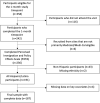Perceived vulnerability to immigration policies among postpartum Hispanic/Latina women in the MADRES pregnancy cohort before and during the COVID-19 pandemic
- PMID: 36148937
- PMCID: PMC9511002
- DOI: 10.1177/17455057221125103
Perceived vulnerability to immigration policies among postpartum Hispanic/Latina women in the MADRES pregnancy cohort before and during the COVID-19 pandemic
Abstract
Introduction and objectives: Research suggests that perceived immigration policy vulnerability has important health implications. Coupled with the mental and physical stressors accompanying the postpartum period and a growing awareness of the discrimination and structural racism experienced by marginalized communities globally, the coronavirus disease 2019 period may have exacerbated stress among vulnerable populations, specifically postpartum Hispanic/Latina women. This study evaluated perceived immigration policy vulnerability (i.e. discrimination, social isolation, and family threats) in early postpartum Hispanic/Latina women in Los Angeles before and during the coronavirus disease 2019 pandemic.
Methods: The Perceived Immigration Policy Effects Scale (PIPES) was administered cross-sectionally at 1 month postpartum to 187 Hispanic/Latina women in the MADRES cohort. Respondents between September 2018 and March 2020 were classified as "pre-pandemic" (N = 128), between March 2020 and July 2020 as "early pandemic" (N = 38), and between August 2020 and November 2021 as "later pandemic" (N = 21). Average PIPES subscale scores were dichotomized into "higher" and "lower" groups (⩽median, >median) and logistic regression models were performed.
Results: Approximately half of participants had incomes of <$50,000 (50.3%) and were Latin American born (54.6%). After adjusting for age, nativity, education, income, postpartum distress, and employment status, early pandemic respondents had 5.05 times the odds of a higher score on the perceived discrimination subscale (95% CI: 1.81, 14.11), 6.47 times the odds of a higher score on the social isolation subscale (95% CI: 2.23, 18.74), 2.66 times the odds of a higher score on the family threats subscale (95% CI: 0.97, 7.32), and 3.36 times the odds of a higher total score (95% CI: 1.19, 9.51) when compared to pre-pandemic respondents. There were no significant subscale score differences between later pandemic and pre-pandemic periods.
Conclusion: Higher perceived immigration policy vulnerability was reported among postpartum women during the early coronavirus disease 2019 pandemic versus pre-pandemic periods. This suggests greater social inequities during the early pandemic period.
Keywords: COVID-19; immigration policy concerns; postpartum mental health; public health; women’s health.
Conflict of interest statement
Figures
Similar articles
-
Facing a dual threat: Pandemic stress and immigration policy vulnerability on mental health among Latinx immigrant parents.Int J Soc Psychiatry. 2023 Dec;69(8):2139-2147. doi: 10.1177/00207640231194480. Epub 2023 Sep 10. Int J Soc Psychiatry. 2023. PMID: 37691431
-
Study Design, Protocol and Profile of the Maternal And Developmental Risks from Environmental and Social Stressors (MADRES) Pregnancy Cohort: a Prospective Cohort Study in Predominantly Low-Income Hispanic Women in Urban Los Angeles.BMC Pregnancy Childbirth. 2019 May 30;19(1):189. doi: 10.1186/s12884-019-2330-7. BMC Pregnancy Childbirth. 2019. PMID: 31146718 Free PMC article.
-
Mental Health and COVID-19 Pandemic Stressors Among Latina/o/x College Students with Varying Self and Parental Immigration Status.J Racial Ethn Health Disparities. 2023 Feb;10(1):282-295. doi: 10.1007/s40615-021-01218-x. Epub 2022 Jan 24. J Racial Ethn Health Disparities. 2023. PMID: 35072943 Free PMC article.
-
The intersection of immigration policy impacts and COVID-19 for Latinx young adults.Am J Community Psychol. 2022 Dec;70(3-4):420-432. doi: 10.1002/ajcp.12617. Epub 2022 Jul 28. Am J Community Psychol. 2022. PMID: 35901500 Free PMC article.
-
Women's mental health and COVID-19: increased vulnerability and inequalities.Front Glob Womens Health. 2024 Oct 2;5:1414355. doi: 10.3389/fgwh.2024.1414355. eCollection 2024. Front Glob Womens Health. 2024. PMID: 39416672 Free PMC article.
Cited by
-
Differences in Breastfeeding Initiation and Duration by Migration History in the Hispanic Community Health Study/Study of Latinos.Breastfeed Med. 2024 Dec;19(12):957-963. doi: 10.1089/bfm.2024.0162. Epub 2024 Oct 2. Breastfeed Med. 2024. PMID: 39355966
References
-
- Couch KA, Fairlie RW, Xu H. The impacts of COVID-19 on minority unemployment: first evidence from April 2020 CPS microdata. NBER working paper no. 27246, May 2020, Cambridge, MA: NBER.
MeSH terms
Grants and funding
LinkOut - more resources
Full Text Sources
Medical



